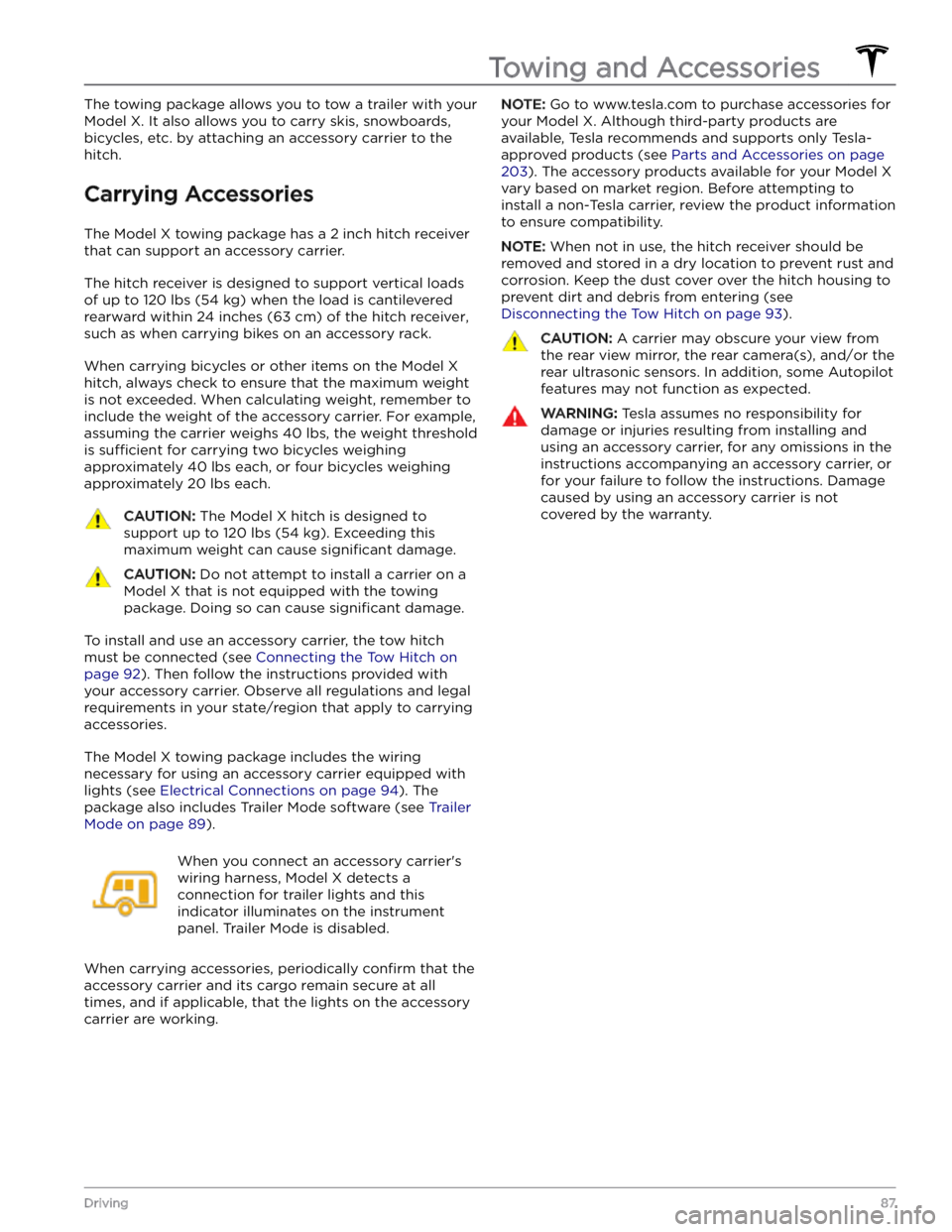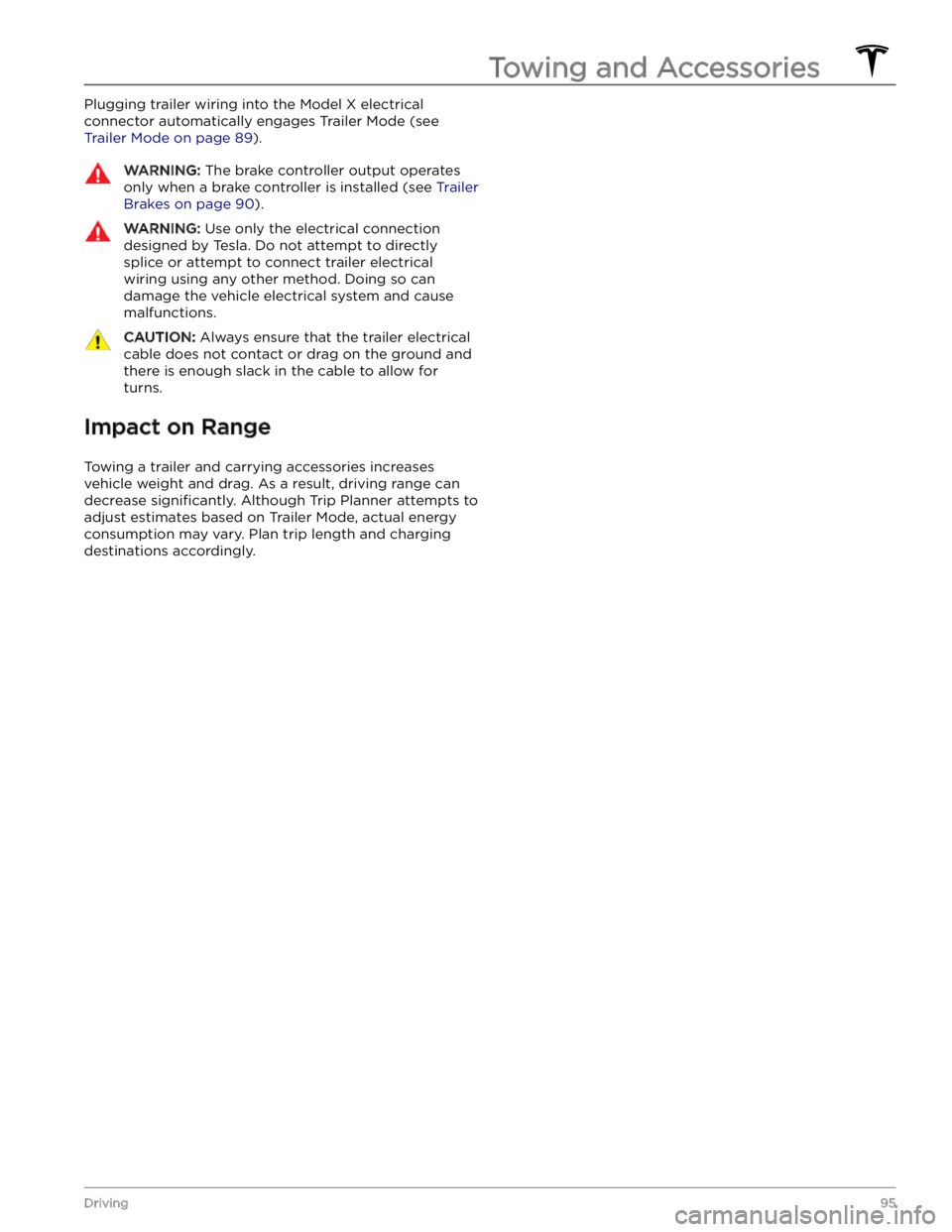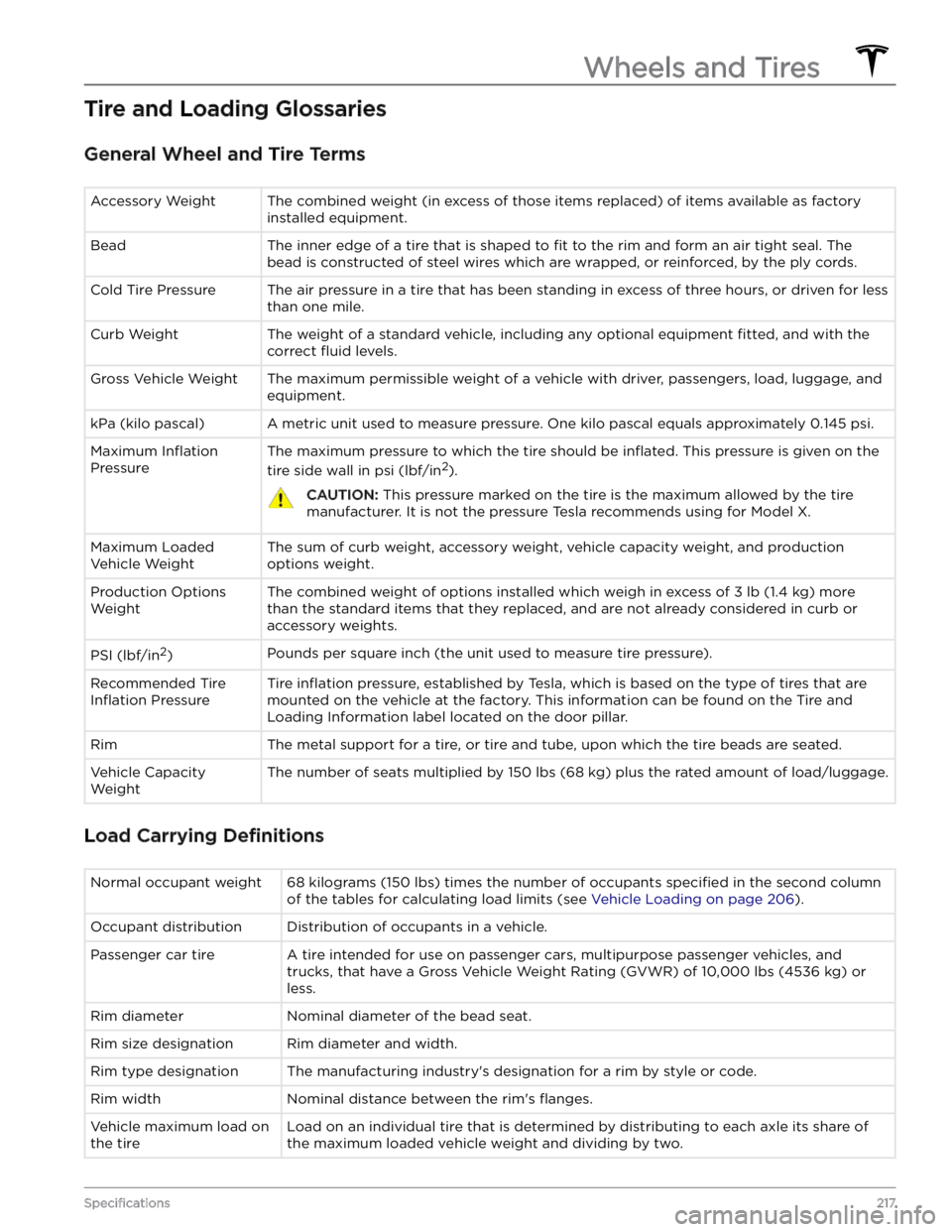weight TESLA MODEL X 2023 Owners Manual
[x] Cancel search | Manufacturer: TESLA, Model Year: 2023, Model line: MODEL X, Model: TESLA MODEL X 2023Pages: 296, PDF Size: 8.56 MB
Page 46 of 296

InfantsToddlersYoung childrenAgeBirth to 1 year*Over 1 year*4 years and older, and
less than 57 in. (145 cm)
tallWeightUp to at least 20 lbs (9 kg)**Over 20 lbs (9 kg) (minimum) and
up to 40 lbs (18 kg)*Over 40 lbs (18 kg)Type of child safety seatRear-facing (or convertible)Forward-facing (or convertible)*Seat belt retained booster
seatSeat positionRear-facing only*Forward-facing*Forward-facingRecommended attachment
methodIf combined weight of child and
safety seat is up to 65 lbs (29.5 kg), attach using either LATCH**
(lower anchor only) or the seat
belt only.*** If combined weight
of child and safety seat is over
65 lbs (29.5 kg), attach using
the seat belt only.***
If combined weight of child and
safety seat is up to 65 lbs (29.5 kg), attach using either LATCH**
(both lower anchors and top
tether anchor), or the seat belt
and upper tether strap.*** If
combined weight of child and
safety seat is over
65 lbs (29.5 kg),
attach using the seat belt and
upper tether strap.***
Attach booster seats
using the seat belt only.* Many child safety seats currently available allow children to ride rear-facing using the child safety seat
Page 49 of 296

WARNING: For vehicles with third row seats, when
a child is seated in a second row monopost seat,
the setting for the button that moves a second row
outboard seat forward for easy access into the
third row should be OFF (touch Controls > Seats >
Easy Entry). This ensures that you need to
manually hold the button to move the seat,
preventing a child seated in the second row from
being pushed against the corresponding front
seat. See #unique_143 on page .
To install a LATCH child safety seat, slide the safety seat
latches onto the anchor bars until they click into place. Carefully read and follow the instructions provided by
the child safety seat manufacturer.
Bench Seats
Monopost Seats
Once installed, test the security of the installation before seating a child. Attempt to twist the child safety seat from side to side and try to pull it away from the seat, then check to ensure the anchors remain securely in place.
NOTE: Lower LATCH anchors should not be used with
child seats or booster seats that have an integrated safety belt in situations where the combined weight of
the child plus the child safety seat is more than
65 lbs
(29.5 kg). In these situations, use the seat belt instead.
Attaching Upper Tether Straps
If an upper tether strap is provided, attach its hook to the anchor point located on the back of the second and third row (if equipped) seats.
NOTE: The location of anchor points may not be readily
visible but can be found by identifying a slice in the
seat
Page 51 of 296

Single Strap - Second Row Bench Seats
Single Strap - Third Row Seats
Testing a Child Safety Seat
Before seating a child, always make sure the child safety seat is not loose:
1.
Hold the child safety seat by the belt path and try to slide the safety seat from side to side and front to back.
2.
If the seat moves more than one inch (2.5 cm), it is
too loose. Tighten the belt or reconnect the
LATCH
retained child safety seat.
3.
If you are unable to reduce slack, try a different seat
location or try another child safety seat.
Child Safety Seat Warnings
WARNING: Extreme hazard! Do not seat a child on
the front passenger seat even if you are using a
child safety seat. This seat has an airbag in front of
it. Although this airbag is disabled when Model X
detects a lightweight passenger, do not rely on
technology to protect your child.
WARNING: Child safety seats are designed to be
secured in vehicle seats by lap belts or the lap belt
portion of a lap-shoulder belt. A child could be
endangered in a crash if a child safety seat is not
properly secured in the vehicle.
WARNING: According to collision statistics,
children are safer when properly restrained in a
rear seating position than in the front passenger
seat.
WARNING: Do not use a forward-facing child
safety seat until your child weighs over 20 lbs (9
kg) and can sit independently. Up to the age of
two, a child
Page 55 of 296

Object ClassificationOCS Passenger Airbag
Status*Indicator statusNotesForward facing child restraint
systemOFFPASSENGER AIRBAG OFF35 lbs (16 kg) or lessChild in a booster seatOFF or ONPASSENGER AIRBAG OFF or
PASSENGER AIRBAG ON20-100 lbs (9-45 kg)*Large childOFF or ONPASSENGER AIRBAG OFF or
PASSENGER AIRBAG ON 5th percentile female or larger
(by weight)ONPASSENGER AIRBAG ONOver approximately 100 lbs (45 kg)*If the passenger airbag status indicator does not match the situation, do not use the seat. The passenger must ride in a different seat. Contact Tesla Service.
NOTE: It takes approximately six seconds after you power on Model X for the occupant classification system (OCS)
to report accurate status of the front passenger airbag. As a result, when you
first power on Model X, even in
situations when it should be OFF because the seat is occupied by a weight of
20 lbs (9 kg) or less, it will take the
touchscreen approximately six seconds to display the status, PASS AIRBAG OFF. If it fails to do so, contact Tesla Service and do not seat a child in the front passenger seating position.
To make sure the sensing system can correctly detect occupancy status, eliminate the following:
Page 89 of 296

The towing package allows you to tow a trailer with your
Model X. It also allows you to carry skis, snowboards, bicycles, etc. by attaching an accessory carrier to the hitch.
Carrying Accessories
The Model X towing package has a 2 inch hitch receiver
that can support an accessory carrier.
The hitch receiver is designed to support vertical loads
of up to
120 lbs (54 kg) when the load is cantilevered
rearward within
24 inches (63 cm) of the hitch receiver,
such as when carrying bikes on an accessory rack.
When carrying bicycles or other items on the Model X hitch, always check to ensure that the maximum weight
is not exceeded. When calculating weight, remember to include the weight of the accessory carrier.
For example,
assuming the carrier weighs 40 lbs, the weight threshold
is sufficient for carrying two bicycles weighing
approximately 40 lbs each, or four bicycles weighing
approximately 20 lbs each.
CAUTION: The Model X hitch is designed to
support up to 120 lbs (54 kg). Exceeding this
maximum weight can cause significant damage.
CAUTION: Do not attempt to install a carrier on a
Model X that is not equipped with the towing
package. Doing so can cause significant damage.
To install and use an accessory carrier, the tow hitch
must be connected (see
Connecting the Tow Hitch on
page 92). Then follow the instructions provided with
your accessory carrier. Observe all regulations and legal
requirements in your state/region that apply to carrying
accessories.
The Model X towing package includes the wiring necessary for using an accessory carrier equipped with
lights (
see Electrical Connections on page 94). The
package also includes Trailer Mode software (see
Trailer
Mode on page 89).
When you connect an accessory carrier
Page 90 of 296

Towing CapacityThe total trailer weight (including all cargo and additional equipment), and the trailer tongue weight, must never
exceed the following:
Wheel/Rim SizeMaximum Towing Capacity*Maximum Tongue Weight**275/45R20 110 V / Y
SAE Class III
Page 97 of 296

Plugging trailer wiring into the Model X electrical
connector automatically engages Trailer Mode (see
Trailer Mode on page 89).
WARNING: The brake controller output operates
only when a brake controller is installed (see Trailer
Brakes on page 90).
WARNING: Use only the electrical connection
designed by Tesla. Do not attempt to directly
splice or attempt to connect trailer electrical
wiring using any other method. Doing so can
damage the vehicle electrical system and cause
malfunctions.
CAUTION: Always ensure that the trailer electrical
cable does not contact or drag on the ground and
there is enough slack in the cable to allow for
turns.
Impact on Range
Towing a trailer and carrying accessories increases vehicle weight and drag. As a result, driving range can
decrease
significantly. Although Trip Planner attempts to
adjust estimates based on Trailer Mode, actual energy consumption may vary. Plan trip length and charging
destinations accordingly.
Towing and Accessories
95Driving
Page 209 of 296

Canada:
Mexico:
CAUTION: To prevent damage, never load Model X
so that it is heavier than GVWR or exceeds the
individual GAWR weights.
Calculating Load Limits
1.
Locate the statement
Page 216 of 296

Understanding Tire Markings
Laws require tire manufacturers to place standardized information on the sidewall of all tires. This information
identifies and describes the fundamental characteristics of the tire. It also provides the tire identification number
(TIN) for certification of safety standards, and in case of a recall.
1.
Tire category: P indicates that the tire is for passenger vehicles.
2.
Tire width: This 3-digit number is the width (in millimeters) of the tire from sidewall edge to sidewall edge.
3.
Aspect ratio: This 2-digit number is the sidewall height as a percentage of the tread width. So, if the tread width is
205 mm, and the aspect ratio is 50, the sidewall height is 102 mm.
4.
Tire construction: R indicates that the tire is of Radial ply construction.
5.
Wheel diameter: This 2-digit number is the diameter of the wheel rim in inches.
6.
Load index: This 2 or 3-digit number is the weight each tire can support. This number is not always shown.
7.
Speed rating: When stated, indicates the maximum speed (in mph) at which the tire can be used for extended
periods. Q=99 mph (160 km/h), R=106 mph (170 km/h), S=112 mph (180 km/h), T=118 mph (190 km/h), U=124 mph (200 km/h), H=130 mph (210 km/h), V=149 mph (240 km/h), W=168 mph (270 km/h), Y=186 mph (300 km/h),
(Y)=vehicle
Page 219 of 296

Tire and Loading Glossaries
General Wheel and Tire Terms
Accessory WeightThe combined weight (in excess of those items replaced) of items available as factory
installed equipment.BeadThe inner edge of a tire that is shaped to fit to the rim and form an air tight seal. The
bead is constructed of steel wires which are wrapped, or reinforced, by the ply cords.Cold Tire PressureThe air pressure in a tire that has been standing in excess of three hours, or driven for less than one mile.Curb WeightThe weight of a standard vehicle, including any optional equipment fitted, and with the
correct
fluid levels.
Gross Vehicle WeightThe maximum permissible weight of a vehicle with driver, passengers, load, luggage, and
equipment.kPa (kilo pascal)A metric unit used to measure pressure. One kilo pascal equals approximately 0.145 psi.Maximum Inflation
Pressure
The maximum pressure to which the tire should be inflated. This pressure is given on the
tire side wall in psi (lbf/in2).
CAUTION: This pressure marked on the tire is the maximum allowed by the tire
manufacturer. It is not the pressure Tesla recommends using for Model X.
Maximum Loaded
Vehicle WeightThe sum of curb weight, accessory weight, vehicle capacity weight, and production options weight.Production Options
WeightThe combined weight of options installed which weigh in excess of 3 lb (1.4 kg) more
than the standard items that they replaced, and are not already considered in curb or
accessory weights.PSI (lbf/in2)Pounds per square inch (the unit used to measure tire pressure).Recommended Tire
Inflation Pressure
Tire inflation pressure, established by Tesla, which is based on the type of tires that are
mounted on the vehicle at the factory. This information can be found on the Tire
and
Loading Information label located on the door pillar.
RimThe metal support for a tire, or tire and tube, upon which the tire beads are seated.Vehicle Capacity
WeightThe number of seats multiplied by 150 lbs (68 kg) plus the rated amount of load/luggage.
Load Carrying Definitions
Normal occupant weight68 kilograms (150 lbs) times the number of occupants specified in the second column
of the tables for calculating load limits (see
Vehicle Loading on page 206).
Occupant distributionDistribution of occupants in a vehicle.Passenger car tireA tire intended for use on passenger cars, multipurpose passenger vehicles, and trucks, that have a
Gross Vehicle Weight Rating (GVWR) of 10,000 lbs (4536 kg) or
less.
Rim diameterNominal diameter of the bead seat.Rim size designationRim diameter and width.Rim type designationThe manufacturing industry